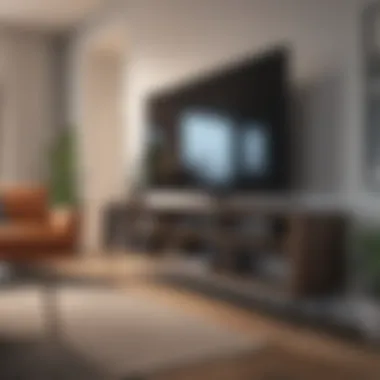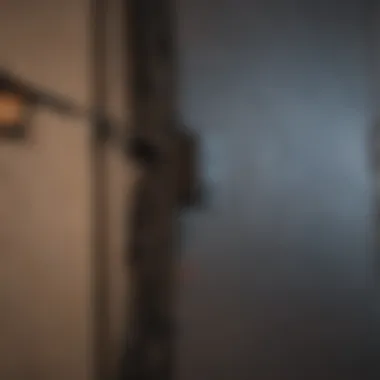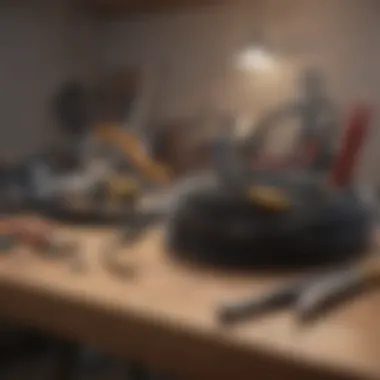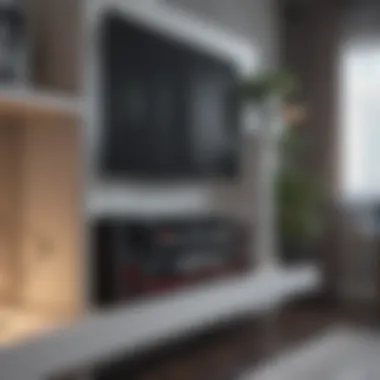Smart Cable Organization Techniques for Modern Homes


Intro
In today’s fast-paced world, technology has pervaded every nook and cranny of our living spaces. With the proliferation of gadgets and devices, it becomes crucial to keep those cables – the veins of our tech – in check. This article dives into the intricate realm of cable organization, providing actionable strategies to reclaim your space from the chaos of cords and cables. Whether you’re a homeowner looking to enhance your interior design or a party host aiming for visual elegance, the methods and insights shared here will elevate your space’s functionality and aesthetics.
Modern living requires not just functionality, but also a keen eye for design. Thus, effective cable management intertwines with aesthetic principles. Let’s uncover the design inspirations and practical steps you can adopt for a cleaner, more organized living environment.
Design Inspirations
Trending Styles
When it comes to organizing cables, embracing a contemporary design style can work wonders. Minimalism continues to lead the charge; sleek, uncluttered designs not only feel calming but also streamline functionality. Think about cable covers that blend seamlessly with your walls, or subtle trays that advance the simplicity of mid-century modern designs.
Go for industrial elements as well. Metal cable trays, often featuring a rugged finish, add a bit of edge and durability to your space. For the tech-savvy homeowners, smart furniture—with built-in cable management compartments—poses as an elegant and practical solution. This design approach not only hides the mess but also accentuates tech-enhanced living.
Color Palettes
Selecting the right color palette for your cable management plan can redefine your space. Neutral tones work particularly well, as they offer a sense of cohesion while easily blending with various decor styles. Shades like beige, white, and gray can make cables less intrusive in an otherwise beautifully decorated room. Alternatively, consider bold hues that can orchestrate a lively conversation—think vibrant reds or deep blues for a playful approach to cable wraps or extension cords.
Additionally, using color-coded cables can present a functional aesthetic. By employing various colors for different devices—like black for your entertainment system and green for your computer setup—you can streamline not only your organization but also your visual experience.
"Good design is as little design as possible." — Dieter Rams
Maintenance and Upkeep
Seasonal Maintenance Checklist
Cable organization isn't a one-time effort; it demands regular attention. Creating a seasonal maintenance checklist is a prudent step forward. Consider the following points:
- Assessment: Regularly review all cables for wear and tear.
- Dust and Clean: Utilizing a microfiber cloth, prevent any buildup on cables and surfaces.
- Re-evaluate: Most importantly, re-check your cable management strategies every season—what worked before might need adaptation based on new devices.
Cleaning and Organization Tips
Keep those cables tidy and efficient by adhering to some straightforward cleaning and organization tips:
- Use Velcro straps: They are a nifty way to keep cords together and easily adjustable.
- Label your cables: Simple labels can prevent confusion when dealing with numerous wires.
- Store unused cables properly: Avoid tangling by coiling and securing any excess cable length.
By carefully implementing these strategies, you can not only manage your cables effectively but also maintain an aesthetic that pleases the eye.
In summary, well-organized cables reflect not just a tidy environment, but elevate the overall visual narrative of your living space. As you journey through these strategies, remember that your space should not only be functional but also a true embodiment of your style.
Understanding the Need for Cable Organization
In today’s bustling homes, cables seem to multiply like rabbits. They snake along walls, tangle around furniture, and often create a visual mess that can push any interior design enthusiast to the brink. Effective cable organization isn't just about aesthetics; it's about improving functionality and safety. By systematically arranging cables, homeowners can create a serene and functional living environment that not only looks good but also feels good to live in.
The Impact of Poor Cable Management
Imagine walking into a room where cables run amok and nothing looks quite right. It isn’t just an eyesore; poor cable management can have real consequences. For one, it increases the risk of accidents. Loose wires can trip people up, leading to potential injuries. Then there’s the fire hazard; frayed cables or overloads can spark a flame, especially if they’re hidden out of sight. Beyond safety concerns, electrical issues can arise from tangled cords that impede airflow and can even damage devices.
It’s clear that having a handle on your cables is not merely for the neat-freaks or design aficionados. It’s a matter of ensuring that your space is safe and functional.
Visual Clutter and Its Effects
Visual clutter can dramatically affect a person's mood and productivity. In a living space overwhelmed by tangled cables, it’s hard to relax or focus. This clutter distracts from the beauty of your design choices, making it seem like the chaos has taken the reins.
Studies show that orderly environments contribute to a sense of well-being. In contrast, disarray can lead to feelings of anxiety or stress. Think of a well-organized office space versus one that’s messy: the former often promotes creativity and productivity, while the latter feels suffocating.
"A tidy environment leads to a tidy mind."
The same principle applies to your home. When cables are managed properly, they cease to dominate your decor, allowing true style elements to shine through. It’s all about harmonizing functionality with design.
Assessing Your Cable Needs
When it comes to organizing cables in a living space, taking a step back to assess your specific needs can make all the difference. Understanding the types of cables you have and how they’re utilized across various areas of your home not only helps in planning but also saves time and effort in the long run. By pinpointing what cables you’re dealing with, how often you use them, and where they’re located, homeowners can strategize on the best ways to manage these tangled, sometimes frustrating, cords.


Identifying Common Cable Types
To effectively tackle cable organization, it’s vital to recognize the most common types of cables you may be working with. Here’s a solid breakdown of what you might find:
- Power Cords: These are the fundamental cables connecting your devices to the electrical outlet. Appliances like televisions, lamps, and gaming consoles fall into this category.
- HDMI Cables: Used for transmitting high-definition video and audio from devices like DVD players or gaming systems to your TV.
- USB Cables: Essential for connecting various devices to computers or chargers. They come in multiple forms, such as USB-A, USB-C, and micro USB.
- Ethernet Cables: If you have a wired Internet connection, you’ll have Ethernet cables linking your router to your devices, ensuring a stable connection.
- Audio Cables: These include everything from speaker wires to auxiliary cables for connecting sound systems.
Making a list of these common cables makes it easier to plan your organization efforts. You might find some cables haven’t been used in a while and can be eliminated. This decluttering can go a long way in simplifying your space.
Understanding Cable Usage in Different Spaces
Now that you have a grasp on the types of cables present, it's time to consider how they are utilized in various spaces throughout your home. Each room’s layout and function lend themselves to different cable management needs.
- Living Room: Cables from entertainment systems, like televisions and gaming consoles, can quickly create a mess. Make careful notes on usage frequency—are they plugged in constantly, or just when you’re tuning in for a show or a game?
- Home Office: Cables for computers, printers, and chargers often coexist here. Given the typically higher number of devices, it’s best to sort these cables based on need—what do you use daily compared to once a week?
- Kitchen: Kitchen gadgets can contribute to cable chaos. With appliances like mixers and coffee machines, think about how often you relocate them and whether they truly need to be plugged in continuously.
- Bedroom: Charging cables for phones and tablets can make nighttime navigation a headache. Consider solutions for concealing these cables while maintaining accessibility for easy nightly charging.
Using this understanding, you can start forming a structured plan tailored to your needs.
"Successful cable management starts with knowing what you have and how it fits into your life. Aim for functionality to get rid of the clutter and enjoy a more spacious living area."
Moreover, paying close attention to the locations where cables are utilized allows for a smarter, more intentional organization. Clarity in approach will not only enhance the aesthetics of your space but also promote functionality, making it easier to manage and locate cables whenever needed.
Strategic Planning for Cable Arrangement
Strategic planning is pivotal when it comes to organizing cables in your living space. It's not just about making things look tidy; it’s about creating an efficient system that enhances your day-to-day life. By mapping out your cables thoughtfully, you can prevent potential hazards, avoid wear and tear, and ultimately make your space feel more harmonious. Aside from the practical benefits, well-planned cable arrangements can significantly elevate the aesthetics of your home. It allows you to maintain an uncluttered environment, which is vital for both the visual appeal and the serene atmosphere of your interior.
Mapping Out Your Space
Before you even lay a finger on your cables, it’s worthwhile to take a step back and assess your living area. Think about where your electronics reside and how frequently you use each device. Grab a piece of paper or a digital tool and sketch a rough layout of your space. Mark the key spots like outlets, devices, and any furniture that might obstruct cable placement.
Here are some points to consider when mapping:
- Identify Outlet Locations: Ensure you know where power sources are situated. This helps in minimizing visible cords and choosing the optimal length for each cable.
- Organize by Usage: Group cables based on how often you plug and unplug devices. Keeping frequently used items accessible saves time and avoids confusion.
- Avoid Clutter Zones: Plan to keep areas clear that naturally tend to attract clutter. Entrances, high-traffic areas, and sections intended for relaxation should remain free from tangled cords.
With a clear layout, you can begin to visualize the best routes for your cables, allowing for an organized approach that prioritizes functionality.
Determining Cable Routes
After mapping out your space, it's time to think about how your cables will actually flow through it. Identifying the best routes involves more than just connecting one end to another; it’s about smart placements that minimize visibility and potential hazards.
Here’s how to determine effective cable routes:
- Utilize Walls and Baseboards: Whenever possible, run cables along walls or baseboards to keep them out of sight. This helps avoid tripping hazards while maintaining a clean look.
- Twist and Turn Wisely: If you’re connecting devices on a shelf or behind your entertainment system, make use of gentle curves instead of sharp turns. Sharp turns can damage cables over time and result in inefficient connectivity.
- Plan for Movement: Reserve some slack in your cables to accommodate adjustments. It ensures you won’t have to replace cables prematurely if you rearrange furniture or electronics.
Choosing the right routes isn’t just about visual appeal; it's about safety, ease of access, and functionality.
By carefully mapping out your space and determining the most effective routes for your cables, you're laying the groundwork for a system that not only looks good but also works seamlessly within your day-to-day life.
Tools and Materials for Cable Management
Organizing cables requires not just a thoughtful approach but also the right tools and materials. These elements play a crucial role in effectively managing the tangled web of cords that often clutter our living spaces. Having suitable equipment can ensure cables are not just out of sight but also remain functional. Moreover, using the right materials can enhance the overall aesthetics of your interior design, creating a seamless blend between style and utility.
Cable Clips and Ties
Cable clips and ties are the unsung heroes in the cable management realm. They��’re simple yet effective solutions for keeping wires tidy and in place. These small devices come in various shapes and sizes, catering to different needs. For instance, adhesive cable clips easily adhere to walls or surfaces and guide cables along a specific path without damaging the surface. They can also help avoid any unsightly tangles at the back of your media console.
On the other hand, Velcro or zip ties offer a more adjustable option, allowing you to bundle multiple cables together without fussy setups. They can be easily loosened or tightened as your cable needs change, making them a versatile option for both temporary and permanent setups. When choosing these clips and ties, consider the material. Opt for reusable options, as they usually offer more flexibility and also help reduce waste.
Cable Sleeves and Covers
Cable sleeves and covers serve a dual purpose: protecting your cords and keeping them organized. These sleeves come in various materials, from fabric to PVC, helping to shield cables from environmental wear and tear. For example, fabric sleeves often provide a softer, more stylish look that blends seamlessly with modern decor, while PVC options are robust and ideal for heavy-duty usage.
One can easily slide several cables into a single sleeve, making it look neater and minimizing the risk of accidents, like tripping over a loose wire. Additionally, investing in a decorative cover can transform an eyesore into an attractive element of your decor, effectively blending function with style. Keep in mind the length and width you require to accommodate your cables—getting the right fit is important for both aesthetics and practical use.
Trays and Organizers
When it comes to larger clusters of cables, trays and organizers come into play. These tools can be particularly useful for home offices or entertainment setups where multiple devices require power. A cable management tray, often mounted under a desk, can neatly contain cables, allowing for a clean look while still providing access to necessary connections.


Furthermore, various designs cater to different needs; some trays feature built-in compartments for power strips or chargers, minimizing clutter even further. Investing in a multi-sectional organizer helps separate cables to avoid confusion and gives each cord its own designated space. This organization method not only looks good but also makes it easier to troubleshoot issues or make adjustments if needed.
"Good organization is not just about semblance; it’s about functionality and ease in utilizing the space available."
Employing the right tools and materials for cable management is not merely cosmetic; it reflects a systematic approach that can simplify daily interactions with technology, ultimately enhancing your lifestyle. Whether you’re utilizing cable clips, protective sleeves, or strategic trays, each element contributes to a harmonious living environment.
DIY Solutions for Cable Organization
In a world where technology is ubiquitous, cables have become an unavoidable part of our lives. However, organizing them in a neat and aesthetically pleasing manner can pose challenges. DIY solutions for cable organization cater to budget-conscious individuals and those who enjoy personalized home decor. By creatively repurposing items you already own or constructing something tailored to your space, you can not only manage cables effectively but also enhance your living environment.
Engaging in DIY projects fosters a sense of accomplishment and creativity. It allows you to devise unique solutions that reflect your style while addressing your specific needs. Moreover, these solutions are often more environmentally friendly, as they recycle household items and reduce waste. With a little creativity and effort, you can transform the chaos of tangled cords into a functional and attractive arrangement.
Repurposing Household Items
A major advantage of tackling cable management as a DIY project is the ability to repurpose items commonly found within your home. Old household products can take on new life with a little imagination. Here are some ideas:
- Empty toilet paper rolls or paper towel tubes: These can be used to keep cords organized. Simply cover them with decorative paper, label them, and use them as cord organizers.
- Mason jars: They can provide an attractive way to store cables. Arrange the cords in the jars by type or length, making them accessible and visually appealing.
- Clothespins: Attaching clothespins to a piece of wood or a small board creates a simple cable holder. Label each clothespin for easy identification.
Repurposing doesn't just leverage household items; it's a chance to engage your creativity. Even kids can take part, turning cable organization into a fun family project. However, ensure the items you choose are sturdy enough to hold the weight of the cords they will contain.
Creating Custom Cable Boxes
If you seek a more refined look, crafting custom cable boxes might be the way to go. These boxes can be tailored to match your décor and specific cable needs.
- Material Options: Start by selecting the right materials. Wood, for example, provides durability and an elegant finish. Alternatively, cardboard can serve as an inexpensive option for short-term use.
- Ventilation: Keep in mind that electronics generate heat. Be sure to design the box with sufficient ventilation holes. This small oversight could save your devices from malfunction due to overheating.
- Finishing Touches: Paint or stain the boxes to match your living space. You can even add decorative elements, like stencils or decoupage, to give them a personal twist.
Making custom cable boxes not only keeps cords hidden but also adds an element of sophistication to your space. You can choose the sizes and dimensions that fit your exact requirements, giving you complete control over the outcome.
"DIY solutions not only solve problems but also add personality to our living spaces."
Integrating Technology and Smart Solutions
In the contemporary living environment, technology has become a cornerstone for enhancing convenience and organization. When it comes to managing cables, integrating smart solutions is not just a luxury; it has turned into a necessity. By employing advanced methodologies and tools, homeowners can vastly improve the functionality and aesthetics of their spaces. The importance of this integration lies in two core aspects: efficiency and elegance. Technological advancements streamline the cable organization process, while innovative designs ensure that functionality doesn’t come at the cost of style.
The benefits of embracing these innovations are manifold. For one, they can simplify your life by reducing visible clutter, making it easier to maintain a serene living space. Moreover, these smart solutions often provide the added advantage of customization, allowing people to tailor their organization systems to fit personal preferences seamlessly.
Some critical considerations include compatibility with existing devices, the effectiveness of wireless solutions, and the overall design aesthetic of the equipment. It’s essential to approach this integration thoughtfully so that it enhances not just utility but also the style of your home.
"Incorporating tech into your cable organization isn’t just about tidiness; it’s about creating a harmonious living environment where every cord has its place."
Wireless Solutions for Device Connectivity
Wireless technology has come a long way, overshadowing the age-old issues of tangled cables and cluttered outlets. Devices that once required numerous cables now operate seamlessly—thanks to wireless capabilities. From Bluetooth speakers to Wi-Fi smart plugs, these solutions encourage a significantly tidier appearance while still delivering performance. This is particularly relevant for modern living spaces designed for aesthetics and minimalism.
Homeowners increasingly leverage wireless connections for numerous devices:
- Smart Speakers: Devices like Amazon Echo and Google Home eliminate the need for various audio cables, allowing for easy control of other smart devices.
- Wireless Chargers: With Qi-enabled devices, keeping your gadgets powered is a breeze without the chaos of cords.
- Streaming Devices: Apple TV and Roku simplify entertainment setups using wireless connectivity, reducing the multitude of HDMI cables required.
When transitioning to wireless solutions, consider the range and signal strength in your space. Occasionally, you might hit dead spots, especially in larger areas. Ensuring strong connectivity can prevent frustration and ensure enhanced functionality. Some setups may benefit from Wi-Fi extenders or mesh networks, which may require minimal cabling but significantly improve wireless reach.
Smart Cable Management Systems
In the age of technology where cables are a persistent element, smart cable management systems have emerged as an invaluable resource. Unlike traditional cable organizers, these systems are designed with the end-user in mind, ensuring both practicality and visual appeal. For instance, think about automated trays or compartments that can adapt based on the number of devices you own.
Using smart cable management can help in a variety of ways:
- Enhanced Accessibility: Systems that allow easy access to cables help reduce the time spent on troubleshooting or unplugging devices.
- Aesthetic Appeal: Wire channels or cable management boxes can match your furniture's design, providing a cohesive look throughout your space.
- Safety Features: Some systems come with built-in protections against overheating, which is crucial in today’s tech-heavy homes.
Consider brands like CableBox or Cable Matters for products designed to meet these modern standards. Their selections typically include items that enhance both organization and style. When choosing a smart system, think about your unique requirements and how different systems can complement your space’s overall function and appearance.
By investing in technology-driven solutions, you are not only simplifying your life but also creating a living environment that radiates sophistication and serenity. This thoughtful integration stands as a testament to modern design principles where practicality and aesthetics go hand in hand.
Aesthetic Considerations in Cable Organization
In today’s living spaces, aesthetics play just as vital a role as functionality. Cables often betray the sleek designs of modern furniture and can turn a serene room into an overwhelming visual mishmash. Thus, considering the aesthetics of cable organization isn’t merely about avoiding unsightly tangles; it is fundamentally about enhancing one’s living environment while promoting a sense of order.


By thoughtfully organizing cables, individuals can maintain the intended atmosphere of a room, whether it’s cozy, elegant, or energetic. An appealing arrangement contributes to overall harmony, making spaces feel more inviting and pleasant to inhabit.
"A well-organized space reflects serenity and clarity, turning chaos into comfort."
Color Coordination with Interior Design
Color coordination is a key element in cable management that is often overlooked. Rather than simply tossing every cable into a box or covering them with unsightly tape, consider the visual impact. Begin by taking stock of your cables and grouping them based on color schemes that align with the existing decor in your home. For example, if your living room features a warm palette of browns and creams, opting for cable sleeves in similar hues can create a more cohesive look.
Moreover, contrasting colors can serve both functional and aesthetic purposes. Brightly colored cables can be strategically placed to add a pop of vibrancy to a neutral space, drawing the eye without overwhelming it. This approach also aids in easy identification, especially in entertainment setups that require frequent adjustments.
Here’s how to practically approach color coordination:
- Identify the primary colors in your room. Consider walls, furniture, and accessories.
- Choose cable management accessories in complementary tones. Items such as cable ties, sleeves, and clips should echo or contrast with your existing color scheme.
- Utilize decorative containers. Use baskets or boxes designed to blend in with your decor while neatly storing cables.
Hiding Cables While Maintaining Style
Concealing cables does not necessitate sacrificing style. Many innovative solutions exist that allow homeowners to hide cables but still maintain an attractive aesthetic. Think about using furniture creatively. For instance, running cables behind media consoles or using bookcases to camouflage excess wiring enables a clean appearance without visible distractions.
Another clever tactic is to leverage wall-mounted or baseboard cord channels that seamlessly blend into the room's architecture. Painting these channels the same color as the wall ensures they remain inconspicuous while keeping cables out of view.
Consider these solutions to maintain your style while neatly hiding cables:
- Cable Boxes: These can be placed near power sources and function as stylish containers for excess cables.
- Under-Desk Solutions: Use cable trays or cord wraps to keep desk areas tidy without cluttering your workspace visually.
- Decorative Items: Integrate cable management into your decor. For example, using decorative fabric to cover a bundle of cables can transform them into an intentional part of your design.
Regular Maintenance for Lasting Organization
Maintaining an organized cable setup isn’t a one-time affair; it’s an ongoing commitment that pays dividends in the long run. Regular maintenance can prevent minor issues from escalating into major headaches. By integrating a few essential practices, homeowners can ensure that their living space remains clutter-free and visually appealing.
Scheduled Checks and Adjustments
A routine schedule for checking your cables can be a game changer. Setting aside time—be it weekly or monthly—allows you to assess the state of your cables without getting overwhelmed. During these checks, it’s wise to look for signs of wear and tear, like frayed insulation or bent connectors.
Here are some practical tips to keep in mind for effective scheduled checks:
- Inspect connections regularly: Loose connections can cause interference, making devices underperform.
- Untangle knots and loops: Watch out for cables that get tangled. Taking a few moments to untwist them can save time later on.
- Clean your workspace: Dust and pet hair can accumulate around cables. A quick wipe-down keeps your setup looking sharp and ensures that devices operate properly.
Think of this maintenance like checking the oil in a car. It’s crucial, yet often overlooked. By keeping a watchful eye, you can catch small issues before they grow into larger problems.
Updating Your Setup
As your technology evolves, so should your cable management strategies. Whether you purchased a new gadget or changed furniture around, it’s vital to assess how these changes affect your cable organization.
Updating involves not just RFID-enabled devices or new smart gadgets, but all aspects of your cable setup:
- Invest in updated organizers: New tools and designs come out all the time. Exploring your options can lead to smarter ways to arrange your cables.
- Re-evaluate cable routes: When setting up new devices, take a moment to map out the most efficient path for cables. This reduces excess length and can even enhance aesthetics.
- Add flexibility: Adopting modular solutions can allow you to rearrange things easily without disrupting everything else.
"Regular maintenance is not just about fixing what’s broken but refining what works."
By treating your cable organization as a living, adaptable system, rather than a static endpoint, you’ll ensure that it remains functional and visually pleasing.
Closure: Achieving Harmony in Your Space
As we wrap up this exploration into the world of cable organization, it’s clear that finding harmony in your living space demands a thoughtful approach to cable management. In an age where technology is intertwined with every aspect of our lives, keeping our cords neat isn't just about aesthetics; it also impacts functionality and mood. An organized space can be likened to a well-orchestrated symphony, where everything plays its part without clashing, allowing for a more peaceful living environment.
The Benefits of Organized Cables
The benefits of having organized cables stretch far beyond simple tidiness. Here are some tangible advantages:
- Enhanced Safety: Loose cables can pose tripping hazards or invite potential electrical issues. A neat arrangement minimizes these risks, making your home safer for children and pets.
- Improved Efficiency: Finding the right cord, whether for a device recharge or connecting to your entertainment system, can be a real headache when cables are tangled. Organized cables streamline this process, allowing you to focus on enjoying your space rather than scrambling to plug in devices.
- Longevity of Equipment: Cables that are properly managed are less likely to suffer wear and tear. When they’re kept untangled and protected, they have a longer lifespan, which saves money in the long run.
- Aesthetic Appeal: A visually pleasing home is often a priority for many homeowners. Concealed or neatly arranged cables uphold the polished look of your space, complementing the overall design rather than detracting from it.
In essence, organized cables contribute to a serene atmosphere, amplifying the aesthetic qualities while offering greater functionality.
Future Trends in Cable Management
As technology evolves, so too do the strategies for managing cables effectively. Here are some emerging trends that homeowners and design enthusiasts should keep an eye on:
- Smart Cable Solutions: With the rise of smart homes, expect to see innovative solutions that integrate seamlessly into tech-driven environments. Wireless charging stations and smart cable management systems reduce clutter, making it easier than ever to keep cables hidden from view.
- Eco-Friendly Materials: Sustainability is at the forefront of many consumers’ minds. Companies are beginning to leverage recycled materials for cable organizers and covers, appealing to environmentally-conscious audiences.
- Modular Organizers: Getting a tailored fit for spaces is becoming increasingly popular. Modular organizers that can be adjusted or expanded based on personal needs provide flexibility while encouraging a customized approach to cable management.
- Minimalist Designs: The trend towards minimalism extends to cable management products as well. Sleek, unobtrusive designs help to maintain a clean look in any room without making cable organization feel intrusive.
"An organized space can be likened to a well-orchestrated symphony, where everything plays its part without clashing."
As you embark on revamping your living space, remember that your cord management efforts will pay off in ways both small and significant.







